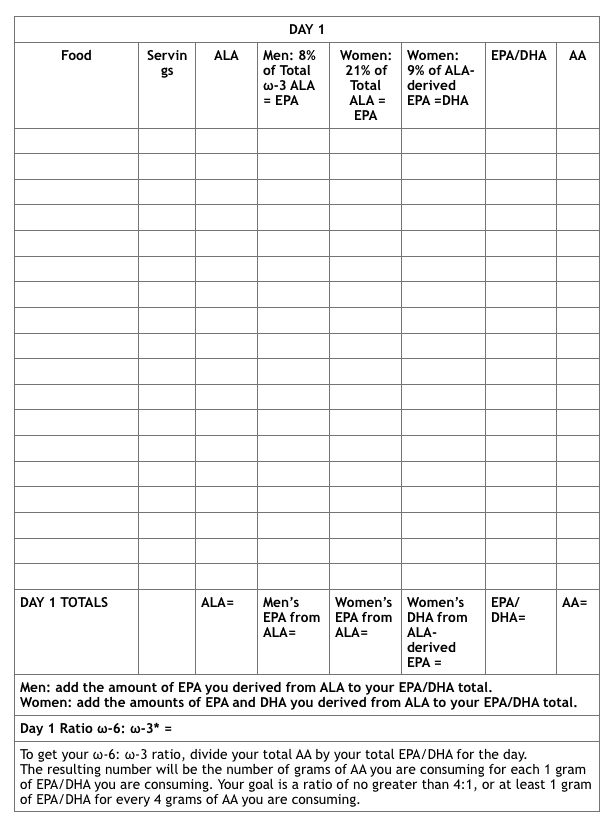This article will explain how to use your Omega-6: Omega-3 diet diary, which was briefly explained in the last article, “How To Determine YOUR Omega 3 Needs.”
To determine how much supplemental EPA/DHA you need for optimal health, what matters most is that you are consuming enough EPA/DHA to maintain proper balance with your intake of AA.
Experts vary in their opinion of what this optimal balance should be. Many say a ratio of omega-6: omega-3 of 4:1 is good; others believe that the optimal balance is 2:1.
How much of the parent compounds of the omega-6 and omega-3 fatty acids — linoleic acid (LA) is the parent omega-6 and alpha linolenic acid (ALA) is the parent omega-3 — you are consuming has much less impact on your omega-6: omega-3 ratio than how much of the pro-inflammatory omega-6 fatty acid, arachidonic acid (AA) and how much of the anti-inflammatory omega-3 fatty acids, EPA and DHA, you are consuming.
Why You Need to Maintain Proper Balance of EPA/DHA with your intake of AA
The type of omega-3 (ω-3) in plant foods (and in meats, but in extremely tiny amounts if present) is ALA (alpha linolenic acid). To produce the majority of the omega-3’s beneficial effects, ALA must be converted into EPA/DHA, which are the types of ω-3 found in fish and seafood. The EPA and DHA forms of ω-3 are the forms that are effective in reducing inflammation and promoting bone, brain and cardiovascular health.
ALA does provide some help in lessening inflammation by competing with LA for the enzymes that metabolize both of these essential fatty acids, but ALA’s effect is minimal compared to the inflammation-fighting effects of EPA and DHA.
The type of omega-6 (ω-6) found in plant foods is LA (linoleic acid), and the type primarily found in meats and dairy products is AA (arachidonic acid). AA is the pro-inflammatory ω-6. Although LA has the potential of being metabolized into pro-inflammatory AA, in actuality, hardly any LA gets converted into AA. In humans, LA is either converted into an anti-inflammatory compound called GLA (gamma linoleic acid) – this is the first step in our metabolism of LA – or LA is burned as fuel to produce energy.
Humans are not good at converting either LA to AA or ALA to EPA.
We convert less than 0.1-0.2% of the LA we consume into AA. Women convert 21% of the ALA they consume into EPA, and 9% of this EPA they derive from ALA into DHA. Men convert somewhere between 5-8% of the ALA they consume into EPA. And most men convert none, 0% of this EPA into DHA. (1)
For the full discussion of how ALA, LA and AA are metabolized, please see the companion article to this diet diary article: How to Determine YOUR Optimal Omega-3 Needs, and my earlier article in this series on the omega-3s: Omega-3s Prevent Our Bones and Muscles from Turning into Fat as We Age.
Step by Step: How to Track Your Omega-6 to Omega-3 Ratio
For these reasons, the most important factors in your food diet diary are the AA present in the foods you eat (primarily meats and dairy products), and the EPA/DHA present in the foods you eat (primarily fish).
If you want to, you can also track your ALA intake, but it will be unlikely to add much to your EPA total, and even more unlikely to affect your DHA total.
If you are a woman and would like to track your ALA intake and analyze its impact on your EPA and DHA total, here’s what you need to do:
Enter the ALA content of the foods on the Commonly Eaten Foods list that you are eating.
- Add up your daily ALA content.
- Take 21% of this amount, this is how much ALA you are likely to convert to EPA.
- Add this number to your EPA/DHA total.
If you are a man and would like to track your ALA intake and analyze its impact on your EPA total, here’s what you need to do:
- Enter the ALA content of the foods on the Commonly Eaten Foods list that you are eating.
- Add up your daily ALA content.
- Take 5% of this amount and add it to your EPA/DHA total.
Now you can determine just how much supplemental EPA/DHA – YOU — require.
In the following, “ω-6/AA” refers to omega-6 in its form as arachidonic acid. “ω-3/EPA/DHA” refers to omega-3 in its forms as EPA and DHA.
- Divide your average daily ω-6/AA intake by 4. This will give you the number of grams of EPA/DHA that YOU require daily to achieve a 4:1 ratio.
For example, if your omega-6: omega-3 ratio is 20:1, you require 5 grams of omega-3 (EPA/DHA) daily to achieve a 4:1 ratio. (20 ÷ 4 = 5)
- Then subtract your average daily EPA/DHA intake (which is the amount of EPA/DHA your diet is typically providing you) from the number of grams of EPA/DHA that you require daily to achieve a 4:1 ratio. This will tell you how many supplemental grams of EPA/DHA YOU require for a 4:1 ratio.
If you seek to achieve a 2:2 omega-6: omega-3 ratio:
- Divide your average daily omega-6 intake by 2. This will give you the number of grams of EPA/DHA that YOU require daily to achieve a 2:1 ratio. The resulting number will be the number of grams of EPA/DHA YOU need daily to achieve a 2:1 ratio.
- Then subtract your average daily EPA/DHA intake from the number of grams of EPA/DHA that you require daily to achieve a 2:1 ratio. This will tell you how many supplemental grams of EPA/DHA YOU require for a 2:1 ratio.
Example: Diet Diary Page 1

For The Full 5 Day Diet Diary, Download Here.
Sources:
Adam O, Tesche A, Wolfram G. Impact of linoleic acid intake on arachidonic acid formation and eicosanoid biosynthesis in humans. Prostaglandins Leukot Essent Fatty Acids. 2008 Sep-Nov;79(3-5):177-81. doi: 10.1016/j.plefa.2008.09.007. Epub 2008 Oct 29. PMID: 18973995
Plourde M, Cunnane SC. Extremely limited synthesis of long chain polyunsaturates in adults: implications for their dietary essentiality and use as supplements. Appl Physiol Nutr Metab. 2007 Aug;32(4):619-34. PMID: 17622276
Whelan J. The health implications of changing linoleic acid intakes. Prostaglandins Leukot Essent Fatty Acids. 2008 Sep-Nov;79(3-5):165-7. doi: 10.1016/j.plefa.2008.09.013. Epub 2008 Nov 5. PMID: 18990554
Blasbalg TL, Hibbeln JR, Ramsden CE, et al. Changes in consumption of omega-3 and omega-6 fatty acids in the United States during the 20th century. Am J Clin Nutr. 2011 May;93(5):950-62. doi: 10.3945/ajcn.110.006643. Epub 2011 Mar 2. PMID: 21367944
Burdge G. Alpha-linolenic acid metabolism in men and women: nutritional and biological implications. Curr Opin Clin Nutr Metab Care. 2004 Mar;7(2):137-44. PMID: 15075703






Article Comments